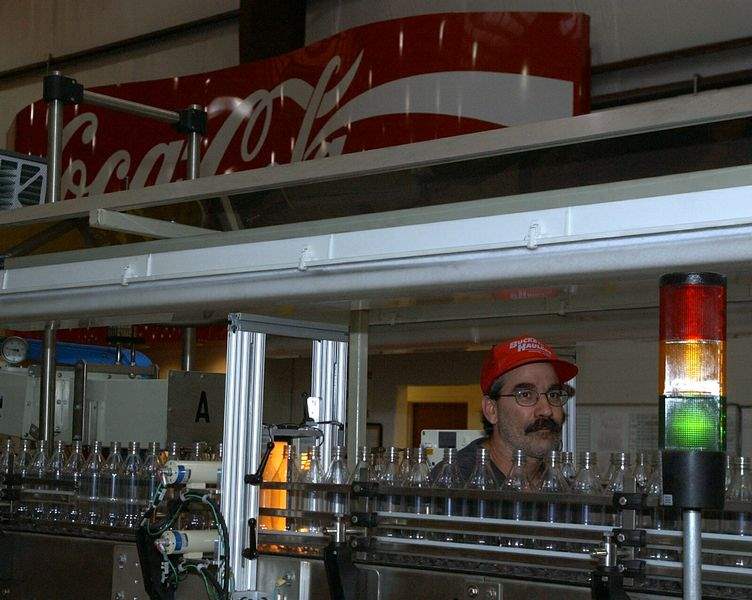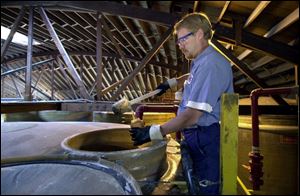
Manufacturing beefs up
9/5/2004
Gary Russell inspects bottles being made at Southeastern Container, where employment has nearly doubled in five years. the blade/andy morrison Andre Ryan takes an alum sample at GAC MidAmerica, which is feeling the pinch of higher raw-materials costs.
king / blade

Gary Russell inspects bottles being made at Southeastern Container, where employment has nearly doubled in five years. the blade/andy morrison Andre Ryan takes an alum sample at GAC MidAmerica, which is feeling the pinch of higher raw-materials costs.
Factory activity in northwest Ohio has chugged along well so far this year, much better than in recent years, and it has meant some hiring and optimism.
Jeff Fay, general manager of the 400,000-square-foot Southeastern Container Inc. plastic-bottle plant in Bowling Green, said the company has nearly doubled its employment base to roughly 100 workers since its opening five years ago.
"We've been growing in sales and employment every year and have had building expansions just about continually," he said.
But higher raw material costs have tempered some enthusiasm because many local businesses say they cannot easily pass along those increases to their customers.
"Customers just aren't biting. They just jump ship and move to another vendor," said Mark Scherer, a spokesman for Master Chemical Corp. in Perrysburg.
The 150-employee company, a global maker of cutting and grinding fluids used in such industries as automotive and aerospace, reports growth after a number of down years, most especially in Asia.
Both businesses are examples of the strength of the local manufacturing sector.
An index of local factory activity shows growth for 10 months, a streak unseen for at least seven years.

Andre Ryan takes an alum sample at GAC MidAmerica, which is feeling the pinch of higher raw-materials costs.
But the local measure prepared by Toledo's Regional Growth Partnership has lagged the factory readings nationally for six of the first seven months this year, which some attribute to the area's heavy reliance on the automotive sector.
"The auto sector has … been a little bit sluggish," said Randy Leffler, spokesman for the Ohio Manufacturers Association in Columbus. "But there has been growth in the state, including in employment and productivity."
The index also doesn't necessarily jibe with the big job losses among area manufacturers, which generally have done limited hiring in the past year.
Many have boosted productivity with technology and efficiency without necessarily adding a lot of jobs.
Also, the region has had some major factory closing announcements this year, notably the Northwood auto parts plant of Alcoa Inc. of Pittsburgh, which has 140 jobs.
Eileen Granata, acting chief operating officer of the growth partnership, said the local index is more volatile than its national counterpart because of dominance of the automotive industry and the smaller sample on which it is based.
The index, derived from surveys of about 60 small to medium-sized businesses in Lucas, Wood, Fulton, and Ottawa counties, has these components: production, new orders, employment, inventories, vendor deliveries, and commodity prices.
For the index itself and the first three components, a reading above 50 is considered growth. For inventories, deliveries, and prices, a reading below 50 is considered best.
The latest index, for July, was 52.7. The national figure was 62.
Only three times in the past 10 months has the local level exceeded 60; the national level did so nine times.
Still, several area manufacturers say business has improved in the past year.
John Toth, president of Toledo Gearmotor Co. in Sylvania, said: "Last year was absolutely miserable. But this year, we're making money and last month was our best month in two years."
The company makes gear mechanisms, such as the piece that would turn a rotisserie, for a variety of commercial customers in several countries.
It has two dozen employees, including four hired in the last three weeks, with more hires expected, Mr. Toth said.
Although local companies are becoming more optimistic about the economy, many acknowledge they're concerned about rapidly increasing costs of raw materials.
Tim Poure, president of GAC MidAmerica Inc. in Sylvania Township, a chemical and distribution company, said, "We're finding an awful lot of our raw materials are in high demand overseas, especially in China."
The economy is about what he expected, he said. His company employs 45, including 22 in the Toledo area.
"So, we continue to have upward pressure on our costs, which is putting upward pressure on our price to our customers," he said.
Tim Coleman, a Toledo vice president for Huntington National Bank, said businesses are struggling with how to deal with increased costs and pressure to reduce their price to their customers.
"[It's] forcing difficult choices with regard to capital investment, in both people and equipment," he said.
The local manufacturing index shows commodity prices have been far above the desired level of 50 - ranging from 73.9 to 84.8 - since the start of the year. That, experts say, is a clear indication manufacturers are paying higher prices for raw materials and for fuel.
Similarly high but not necessarily healthy in the index are vendor deliveries. They have been above 50 for each of the first seven months of this year, ranging from 52.5 in January to 62.8 in May.
The consistently higher numbers can mean companies are getting materials from suppliers at a slower pace, which eventually could affect production speed, one expert said.
Those surveyed for the local index are asked whether the firm has hired or dismissed employees in the past month; the higher the reading, the better the employment picture. In July, the reading was 57.8, up from 56.4 in June, and considerably higher than the summer figures a year ago.
However, metro Toledo unemployment remains relatively high. Lucas County's most recent jobless rate was 8.5 percent, with nearly 20,000 out of work. The rate in Fulton County was 9.5 percent. Wood County was lower, at 6.7 percent, but that is higher than a year ago.
At Southeastern Container's plastic-bottle plant in Bowling Green, employment is as high as it has ever been. Mr. Fay, general manager, said the factory runs around the clock almost every day.
He attributes the growth to the firm's niche of making plastic bottles for Coca-Cola and its Dasani water line, shipping mostly to plants in Ohio and Michigan.
Jack Albano, manager at the Millbury plant of Guardian Industries Inc., said the company has had a 40 percent increase in heavy truck sales, which is about 35 percent of its business.
The plant has 199 employees and produces safety tempered and laminated glass products for the automotive, heavy truck, school bus, and farm and construction equipment markets.
"And we have gained significant market share in the school bus and ag-con markets," he said.
Contact Mary-Beth McLaughlin at mmclaughlin@theblade.com or 419-724-6199.